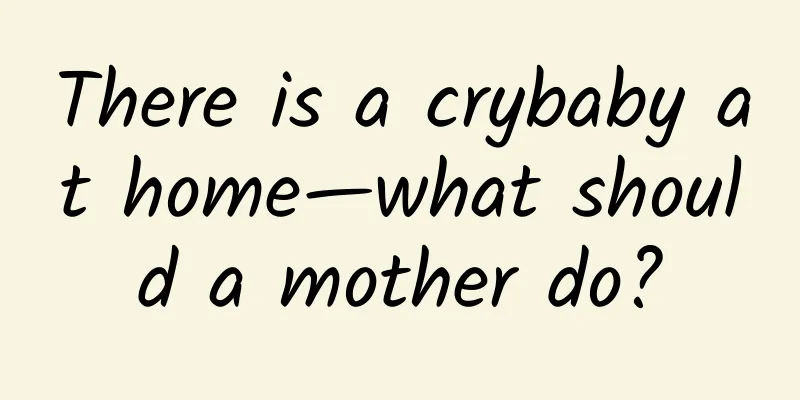There is a crybaby at home—what should a mother do?

|
Parents often ask in the clinic: "My child always loves to cry. When she cries, my heart aches. I really hope that the crying will stop soon. Sometimes I feel upset and can't control myself. What should I do if I want to lose my temper?" Parents and friends, don't worry, let's first understand what "crying" means. British psychoanalyst Winnicott divides the meaning of "crying" into four categories: the first is satisfaction, the second is pain, the third is anger, and the fourth is sadness. Let's take a look at the different meanings of "crying" and how to deal with it. First, there is the crying of satisfaction. How can babies cry to satisfy themselves? This must be very puzzling. In fact, babies' crying is not necessarily to express anxiety or uneasiness. Sometimes they cry for happiness. In the medical field, obstetricians will judge whether the newborn is healthy and strong by the cry of the newborn. Children with loud cries are often healthier. In addition, crying is also a form of early exercise for babies. This kind of crying can make babies very satisfied. So babies who don't cry enough may not be satisfied enough. Crying in anger. When a baby cries in anger, he may act as if he wants to destroy everything around him, including himself. At this time, if his mother can remain calm and not panic, then this process will help strengthen the baby's ability to see the truth and help him distinguish between fantasy and reality. So when a baby cries in anger, parents must respond calmly. Sad crying. What should we do when a child is crying because of sadness? When a child is in a sad mood, it takes a while for the child to recover, just like adults. It is best for the mother to let the baby cry for a while. Because for a baby who cannot speak yet, after he cries for a while, the mother should use empathy to give meaning to the child's crying and understand the child's sadness. The mother can hold the baby and say to him gently: "Baby, you were very sad just now, right? Mom knows that you are crying because of sadness. Do you feel better now?" Don't think that the baby doesn't understand anything. In fact, the baby can understand what the mother says. In this way, the next time the baby is sad, he will know that this similar feeling is called "sadness." Painful crying. When a child cries because of something painful, we need to stay by his side. We should not just hug the child and coax him, but should first ask for his opinion. This is because if we hug the child without any explanation, this behavior is just the mother's own desire, not the child's need. The mother can squat down and hold the child's hand, look at the child firmly and warmly, and ask softly: "Baby, can I hug you?" In life, many young mothers are at a loss when they hear their children crying, and some even get anxious. Of course, mothers love their children very much and hope to quickly meet their babies' needs, but some mothers will feel uneasy deep in their hearts when they hear their babies crying. In fact, many of us grew up in the suppression and restraint of crying, and many adults have not learned how to place their emotions. So, when we hear our children crying, how can we not panic and be in a mess? Some mothers therefore try every means to satisfy their children as soon as possible. On the surface, it is to make the children stop crying, but from a deeper perspective, it is also to calm or cover up their inner anxiety. To sum up, when children cry, mothers should not be anxious. No matter what the crying means, they should first pay active attention to the child's current feelings. When the child's emotions have calmed down a little, ask the child why he cried just now? When the child is willing to tell us, the answer will naturally come out. However, when the child is in the process of releasing emotions, if the parents repeatedly stop the child from crying and ask the child to explain the reason for crying, it is difficult for the child to vent emotions and organize language at the same time. This behavior of the parents is an interruption of emotional catharsis for the child. It not only interrupts the child's connection with his own emotions, but also the emotions may be continuously suppressed and cannot be fully released. Over time, it becomes an emotional problem. I hope mothers can understand their children’s crying behavior and be able to identify the reasons for their children’s crying behavior, put aside their anxiety, and respond to their children’s “crying” scientifically. Zhang Chi, Children's Encephalopathy Diagnosis and Rehabilitation Center, First Affiliated Hospital of Henan University of Traditional Chinese Medicine |
>>: A "burning" oral disease! This article tells you the truth
Recommend
What are the causes of uterine contractions in early pregnancy?
Many pregnant women will experience uterine contr...
Measures to treat spots after miscarriage
Many women will start to develop spots on their f...
Don't take the hot weather lightly, heat stroke is not a trivial matter
Author: Wang Changyuan, Chief Physician, Xuanwu H...
Is moyamoya disease caused by smog? Understand moyamoya disease and detect and treat it early!
Author: Han Hongyan, Chief Physician of Aviation ...
What causes black blood clots during menstruation?
Many women have menstrual problems. Under normal ...
Is painless abortion harmful to the body?
As the competition pressure in all walks of life ...
Do you gain or lose weight during your period?
Weight generally increases during menstruation, m...
How to solve urinary incontinence after sex
Urinary incontinence after sexual intercourse has...
What medicine can make menstruation come?
If a woman has amenorrhea, it is most likely that...
How long does it take for a woman's menstruation to end?
A woman's menstruation is like the temperatur...
Can my aunt eat apples?
You can eat a small amount of fruit during your p...
Why am I covered in hair?
If a girl has thick body hair, it will put a grea...
How to accurately prevent sagging breasts during breastfeeding?
Mothers bear an important responsibility in nurtu...
Ovarian removal surgery
Ovarian removal surgery is performed to treat dis...
Protect the pillar of the body - the cervical spine, and say goodbye to pain!
In modern society, more and more people are seden...









